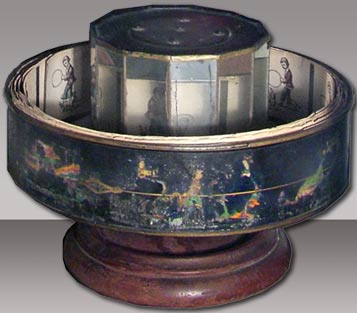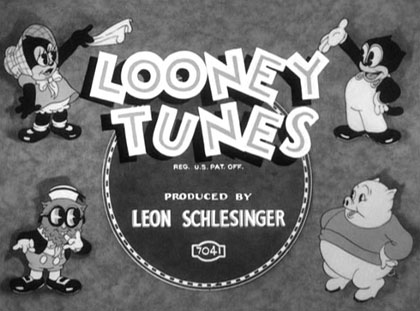
Joseph was a Belgian man from Brussels that studied at the University of Liége where he graduated in 1829 as a doctor of physical and mathematical sciences. In 1835 he was appointed Professor of experimental physics in Ghent University. The Phenakistoscope was later created by him in 1841.
The Phenakistoscope was constructed of two discs mounted together on a spindle; the first disc had slots around the edge, and the second contained successive drawings drawn around the disc. The two discs would spin in the same direction and people could view the animation through a mirror. Basically, the Phenakistoscope used the persistence of motion principles to create the illusion of motion. Plateau took influence from Michael Faraday’s Wheel and in which he improved the idea.
After it was taken to market it was given other names including Phantasmascope and Fantoscope. It was successful for a couple of years until the Zoetrope was invented by George Horner; this invention offered improvements.
The Zoetrope

William Horner was a British mathematician, school master, headmaster and school keeper. Due to his early death there isn’t much information recorded about him. Horner invented the zoetrope (originally Daedalum) in 1833.
The original name was discarded prior its release to America as it means ‘The Wheel of The Devil’; the new name means ‘The Wheel of Life’.
The inner mechanics of the Zoetrope are based on the persistence of vision and the PHI phenomenon. Due to the fact humans have slow vision the persistence of vision theory can exist. The Zoetrope consisted of flashing lights every tenth of a second because it would make the images appear continuous as the retina persists making the images overlap. Looking over the drum however makes the animation blurred because the interruption is required to make it work.

William Horner was a British mathematician, school master, headmaster and school keeper. Due to his early death there isn’t much information recorded about him. Horner invented the zoetrope (originally Daedalum) in 1833.
The original name was discarded prior its release to America as it means ‘The Wheel of The Devil’; the new name means ‘The Wheel of Life’.
The inner mechanics of the Zoetrope are based on the persistence of vision and the PHI phenomenon. Due to the fact humans have slow vision the persistence of vision theory can exist. The Zoetrope consisted of flashing lights every tenth of a second because it would make the images appear continuous as the retina persists making the images overlap. Looking over the drum however makes the animation blurred because the interruption is required to make it work.
 The Praxinoscope
The PraxinoscopeÉmile Reynaud was a French science teacher that was considered an inventor, artist and showman. In 1876 he set out to improve the Zoetrope in the form of a child’s optical toy. The Praxinoscope was created in 1877 and it had improvements that included its clarity and ability to be projected.
The Praxinoscope was better for viewing as the animation could be viewed in the mirrors unlike the Zoetrope that was viewed through small slits. This also meant that numerous people could watch the animation at the same time.
A year late Reynaud created Praxinoscope theatre; this is where a lot of people could gather and watch an animation together. The mirror drum and cylinder were set in a wooden box with a glass-covered viewing aperture; this reflected a card printed with a background. The moving subjects (juggler, clowns, etc) were printed on a black band and appeared superimposed on a suitable scene.
Zoopraxiscope
 Eadweard
Muybridge was a British photographer best known for his studies in motion and
motion-picture projection. In 1879 Muybridge invented the Zoopraxiscope; a
device that projected images from rotating glass discs at a fast pace to give
the illusion of motion. The stop-motion pictures were painted onto the discs in
a sequence representing the phases of motion.
Eadweard
Muybridge was a British photographer best known for his studies in motion and
motion-picture projection. In 1879 Muybridge invented the Zoopraxiscope; a
device that projected images from rotating glass discs at a fast pace to give
the illusion of motion. The stop-motion pictures were painted onto the discs in
a sequence representing the phases of motion. 
Thomas Edison was an American inventor and businessman; he invented numerous devices that affected life around the world greatly. In 1893 the Kinetoscope was invented by Edison to revolutionise the way animation was viewed. He aimed to project the images into the viewer’s eye instead of allowing them to look at still images. The original Kinetoscope design was to coat a tube with images and spin it while shining a light from the inside. The design was based on the photograph and it was very similar to it. He abandoned the idea after deeming it was impractical for multiple use.
The working model was unveiled by Edison at the Brooklyn Institute of Arts and Sciences in 1893. The Kinetoscope was a four foot high box that contained a number of sprockets, a lamp and over 50 foot of film. The film was moved through the box in a loop and the internal lamp produced ‘intermittent light’ that projected the image into the viewing piece/peephole.
Kinetoscope films were mainly shot in The Black Maria which was Thomas Edison's movie studio. The studio was specially built in New Jersey; it could rotate and the roof could pivot to allow the correct amount of light to enter. It was later abandoned to build a new glass, enclosed studio on a rooftop in New York.
Cinematographe

The Lumiere Brothers originally started in the photography business developing a dry plate process (the Etiquette Bleue process). It proved to be very popular as they ended up creating 15,000,000 plates a year. They were invited to a Kinetoscope demonstration one day and given a piece of film as a gift; this was a big mistake as once they got back to their company they ordered their workers to create a device similar to the Kinetoscope only at a reduced cost and price so they could bring in a larger revenue and attract more attention. Soon the company produced the Cinematographe which was cheaper and easier to produce than the original design. This invention had improvements as well; the Cinematograph produced less noise and could save film and film costs. However it could only work in 16 FPS whereas the Kinetoscope could work in 48 FPS.
Walt Disney
 Walt
Disney was an American film producer, director, screenwriter, voice actor,
animator, entrepreneur and entertainer; he was born on December 5th 1901. Walt
is primarily known for setting up Disney; however before he did so, he set up
some smaller companies and animation firms.
Walt
Disney was an American film producer, director, screenwriter, voice actor,
animator, entrepreneur and entertainer; he was born on December 5th 1901. Walt
is primarily known for setting up Disney; however before he did so, he set up
some smaller companies and animation firms. Hanna-Barbera
 Hanna-Barbera Productions was an American animation
studio formed in 1957 by animation directors William Hanna and Joseph Barbera
and live-action director George Sidney. The company was established soon after
MGM shut down its animation studio that produced the classic Tom and Jerry
series. Over four decades the studio released many successful animated shows
that are still popular today. They produced the famous The Flinstones, The Yogi
Bear Show, Scooby-Doo, Where Are You!, The Smurfs and much more. The studio
also produced several films and cartoon shorts; the studio received many Oscars
and Emmys for their work. Hanna-Barbera now only exist as an in-name-only
company used to market the companies classic works; this means that their old
cartoons are re-shown on television even now. For example Scooby-Doo is still
very popular and shown on the childrens channels.
Hanna-Barbera Productions was an American animation
studio formed in 1957 by animation directors William Hanna and Joseph Barbera
and live-action director George Sidney. The company was established soon after
MGM shut down its animation studio that produced the classic Tom and Jerry
series. Over four decades the studio released many successful animated shows
that are still popular today. They produced the famous The Flinstones, The Yogi
Bear Show, Scooby-Doo, Where Are You!, The Smurfs and much more. The studio
also produced several films and cartoon shorts; the studio received many Oscars
and Emmys for their work. Hanna-Barbera now only exist as an in-name-only
company used to market the companies classic works; this means that their old
cartoons are re-shown on television even now. For example Scooby-Doo is still
very popular and shown on the childrens channels.Warner Bros.
 Warner Bros. Entertainment is an American production studio of film,
television and music entertainment. The company was founded in 1918 by brothers
Albert, Harry, Sam and Jack Warner. The company was a pioneer of films with
synchronised sound (or 'talkies'). Initially only two brothers wanted to produce films with sound and the others refused but after a number of unsuccessful projects they decided to give it a go; it became a huge success. For ten years the brothers continued to create short films with sound and colour but in 1931 they switched their attention to realistic, films that would relate to the audience. The Little Ceasar was produced in 1931 and became a box office success; many more gangster related films were made after that and continued being successful.
Warner Bros. Entertainment is an American production studio of film,
television and music entertainment. The company was founded in 1918 by brothers
Albert, Harry, Sam and Jack Warner. The company was a pioneer of films with
synchronised sound (or 'talkies'). Initially only two brothers wanted to produce films with sound and the others refused but after a number of unsuccessful projects they decided to give it a go; it became a huge success. For ten years the brothers continued to create short films with sound and colour but in 1931 they switched their attention to realistic, films that would relate to the audience. The Little Ceasar was produced in 1931 and became a box office success; many more gangster related films were made after that and continued being successful. In 1930 Warner cartoons were born; this was the start of the Looney Tunes; the show initially only had one main character named Bosko which was in the first episode 'Sinkin' in the Bathtub'. Warner Bros. also produced a sister series named Merrie Melodies. In 1936 Porky Pig, Bugs Bunny and Daffy Duck were added to the series and this was the start of the evolution of the show.
During the World War II period Warner Bros. started producing anti-German films for propaganda purposes. However, when the war ended they focused on happier films; that were mainly womens features.
Now the Warner Bros. focus on releasing movies like Harry Potter and their Looney Tunes series is also re-shown often.
No comments:
Post a Comment